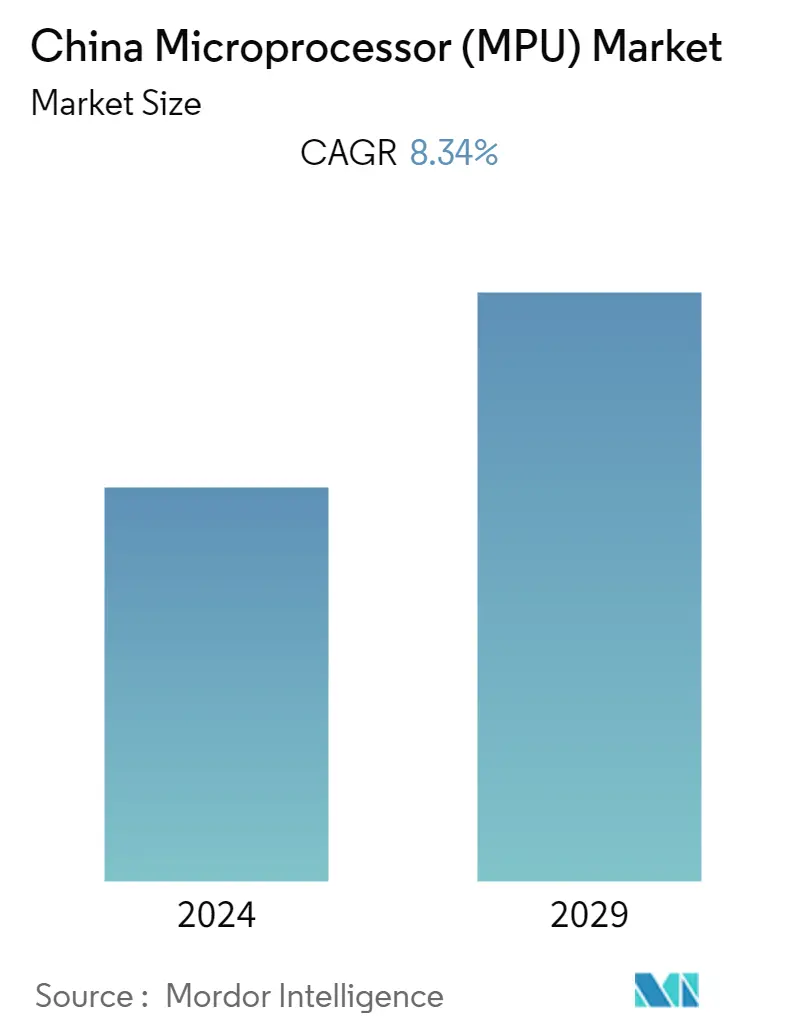Market Size of China Microprocessor (MPU) Industry

| Study Period | 2019 - 2029 |
| Base Year For Estimation | 2023 |
| Forecast Data Period | 2024 - 2029 |
| Historical Data Period | 2019 - 2022 |
| CAGR | 8.34 % |
| Market Concentration | Low |
Major Players
*Disclaimer: Major Players sorted in no particular order |
Need a report that reflects how COVID-19 has impacted this market and its growth?
China Microprocessor (MPU) Market Analysis
The Chinese microprocessor (MPU) market was valued at USD 9.87 billion in the current year. It is expected to reach USD 16.51 billion, registering a CAGR of around 8.34% during the forecast period. The market is expected to witness an increase in demand at the global level owing to the growing use of microprocessors in consumer electronics, such as smartphones, personal computers (PC), and laptops.
- China is assisting the market's growth due to a number of factors, including an increase in digitization, a rise in the use of high-tech devices, and the development of automotive electronics, among others. Additionally, it is anticipated that rising cloud service demand, massive government IT spending, and increased Internet of Things (IoT) usage are expected to support market expansion in China.
- China is taking advantage of the chance to increase its level of microprocessor self-sufficiency and end the US and British companies' monopolies. The most recent effort by China to increase its chip self-sufficiency has focused on microprocessors, the brains of all modern electronics. Since 2022, an increasing number of Chinese chip design companies have substituted open-source RISC-V for Intel's proprietary X86 and Arm's architecture in their chip designs in an effort to reduce the potential harm from US sanctions and save money on licensing fees.
- Chinese internet companies like Alibaba and Baidu have been manufacturing their chips. This is seen as progress toward China's goal of boosting domestic technological capacity. Due to ongoing trade issues and geopolitical considerations, China is working toward chip and semiconductor self-sufficiency. In its 14th five-year plan, China identified seven technological sectors, including artificial intelligence, quantum computing, semiconductors, and space.
- Additionally, a number of new companies in China are rushing into the semiconductor industry, according to Semiconductor Industry Association. Chinese companies registered as semiconductor enterprises number almost 15,000. Many of these new businesses are fabless start-ups with a focus on higher-end chip design, such as GPU, EDA, FPGA, and AI computing. Many companies create cutting-edge chips and design and manufacture devices using cutting-edge process nodes.
- According to SIA projections released in November 2022, China's market share of global chip design will increase from 9% in 2020 to 23% by 2030 (compared to a US decline from 46% to 36%), a significant rise but still far from world-beating. The development of chip design will soon enable Chinese businesses to grow. Such growth is likely to boost the Chinese microprocessor (MPU) market.
- On the other hand, it is anticipated that over the upcoming years, factors like high raw material prices, declining shipments of individual computers, rising sales of low-cost mobile devices, high manufacturing costs for microprocessor integrated circuits, and low-priced mobile device shipments will impede the market growth.
